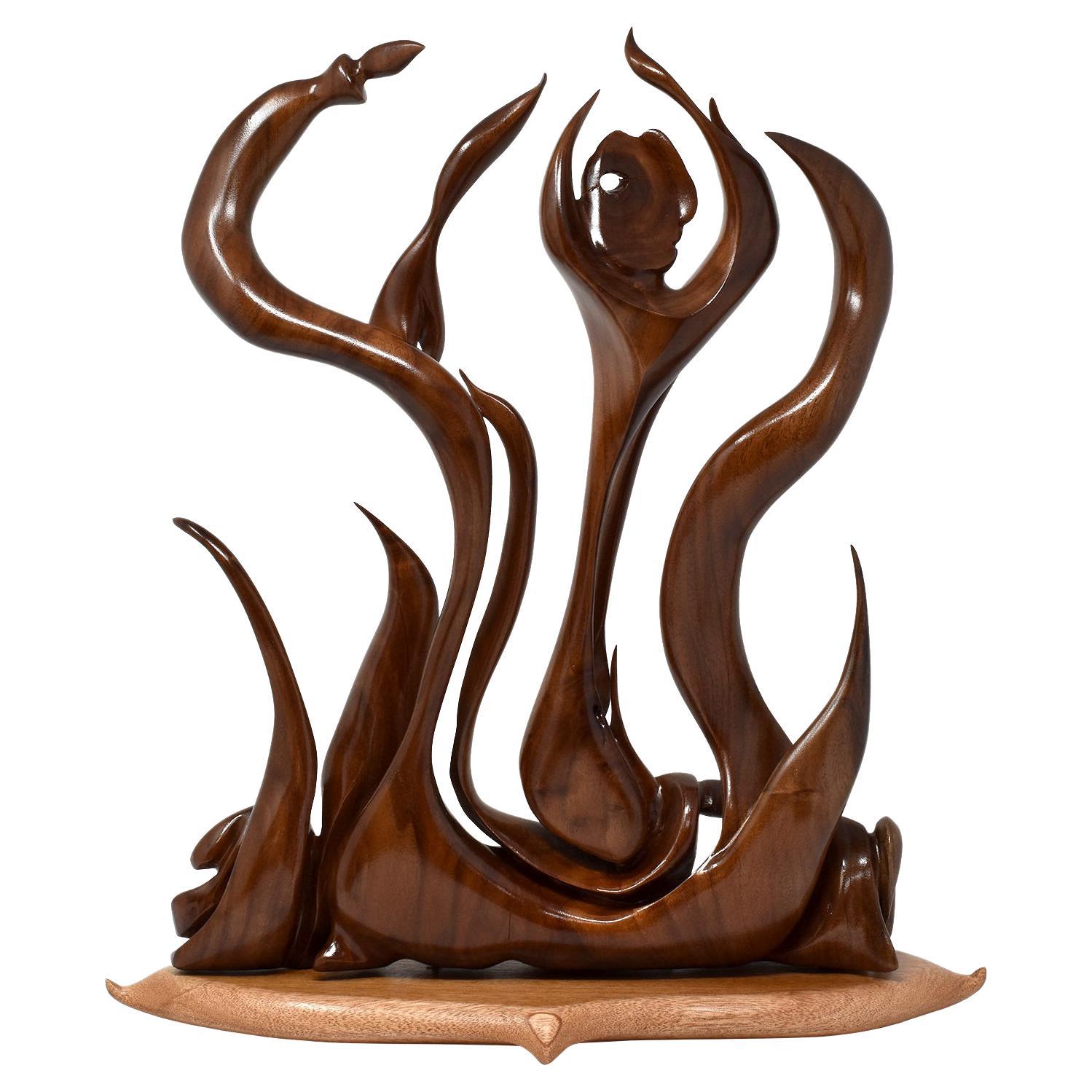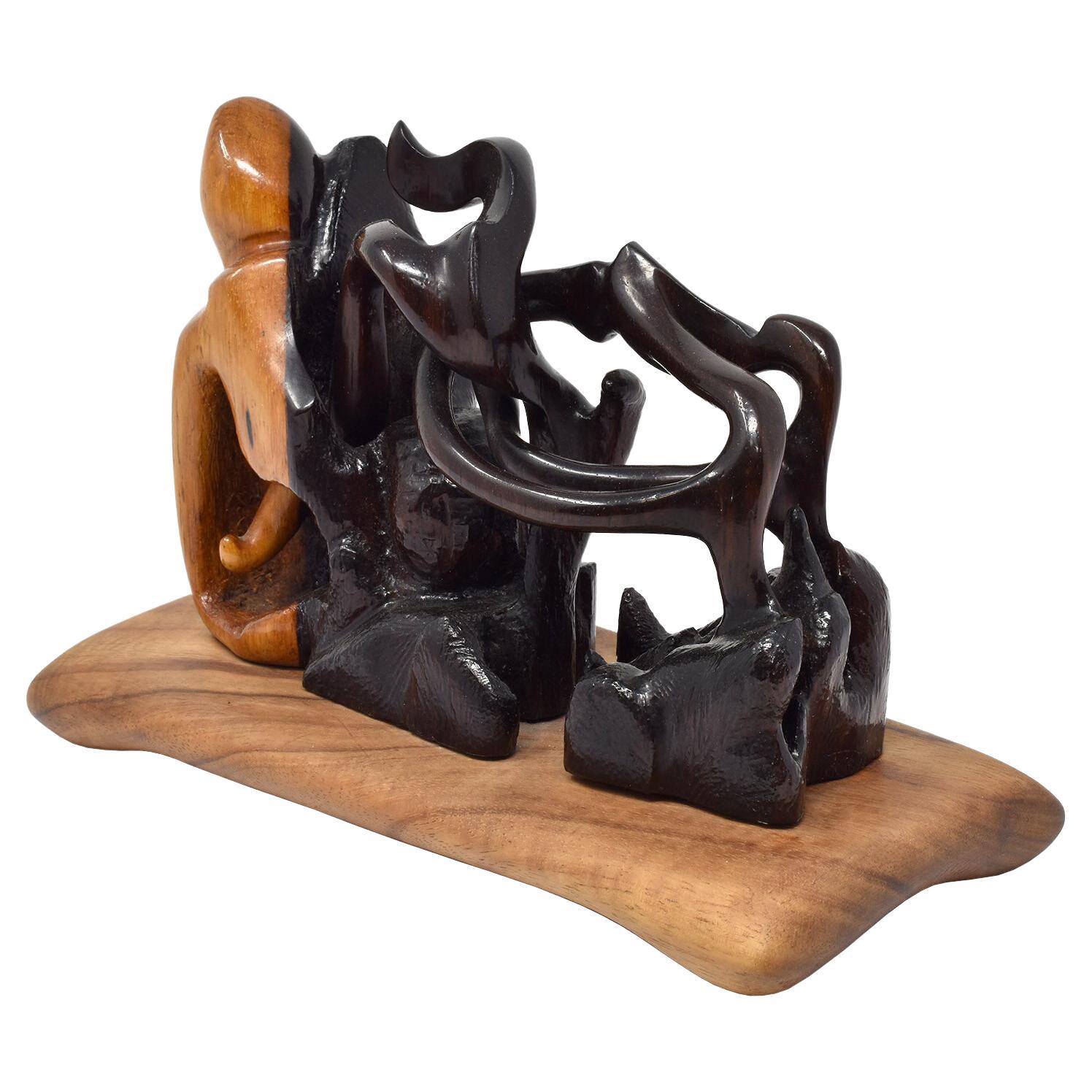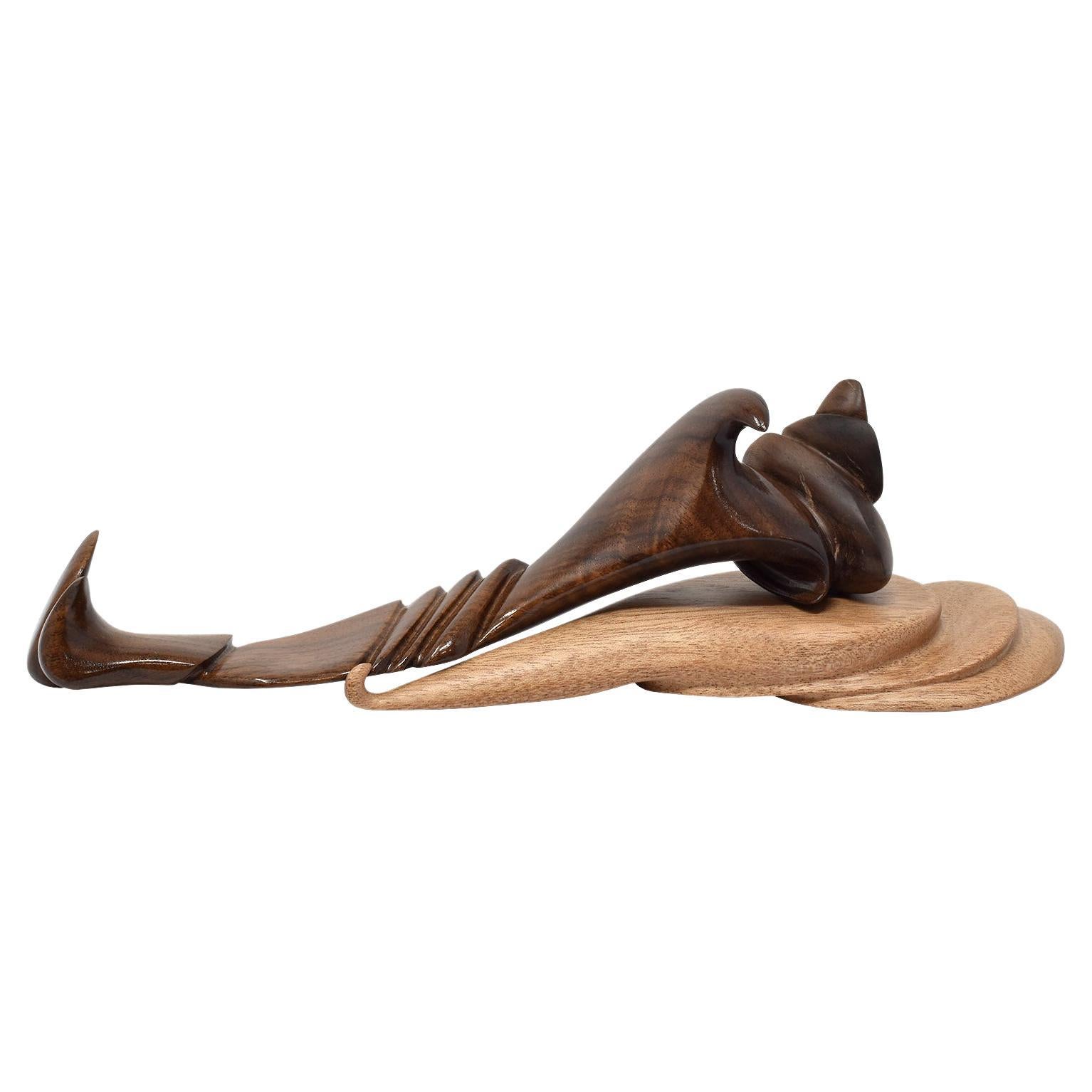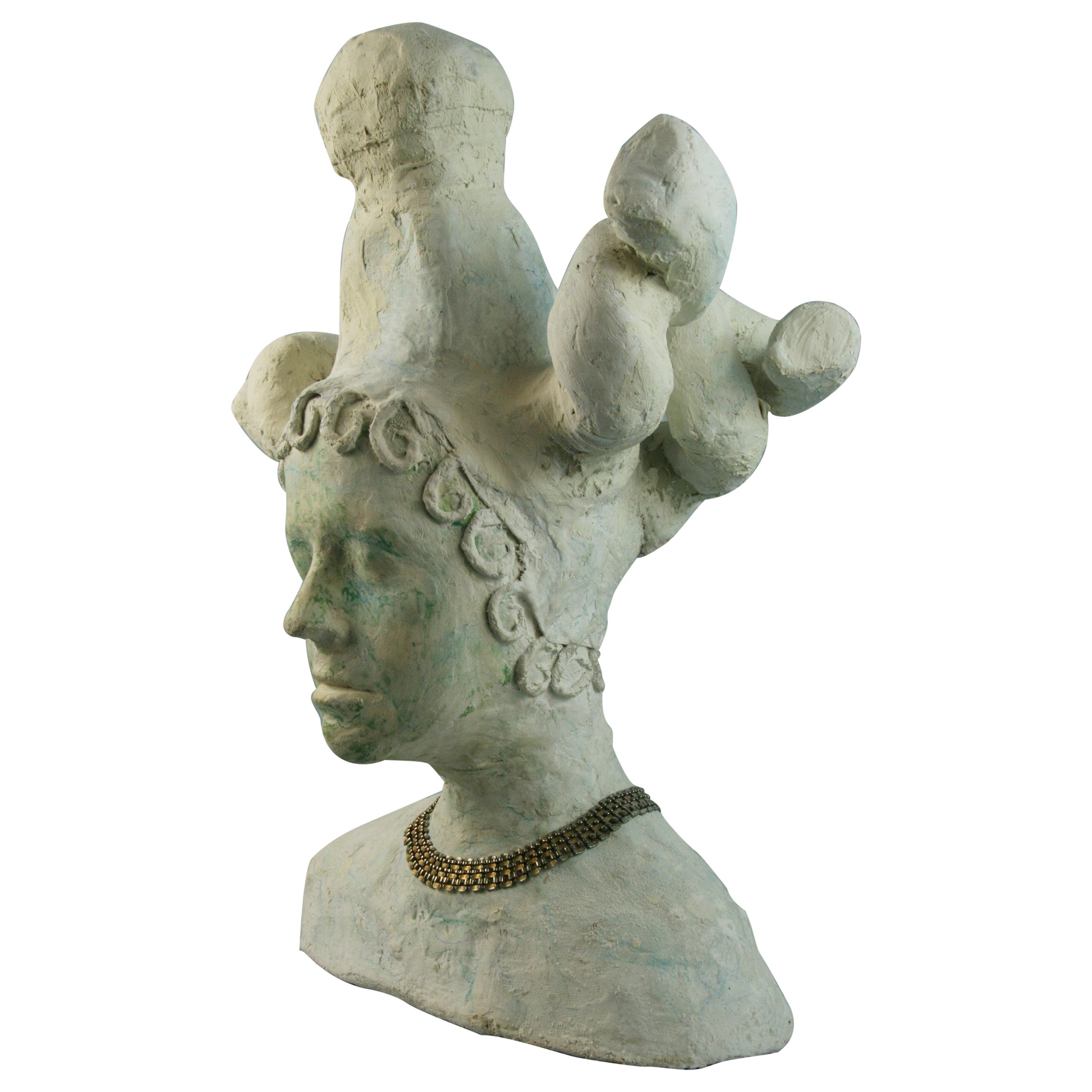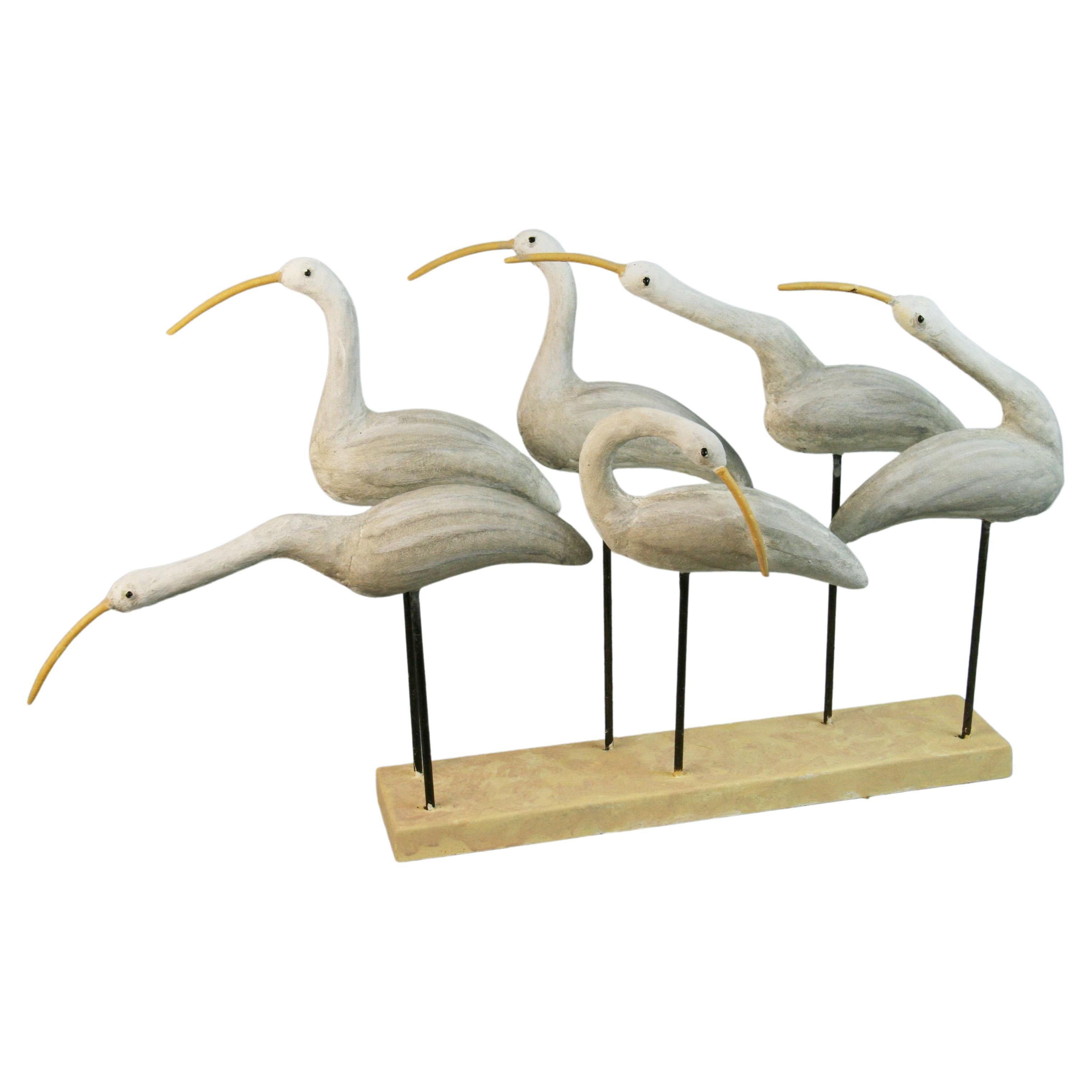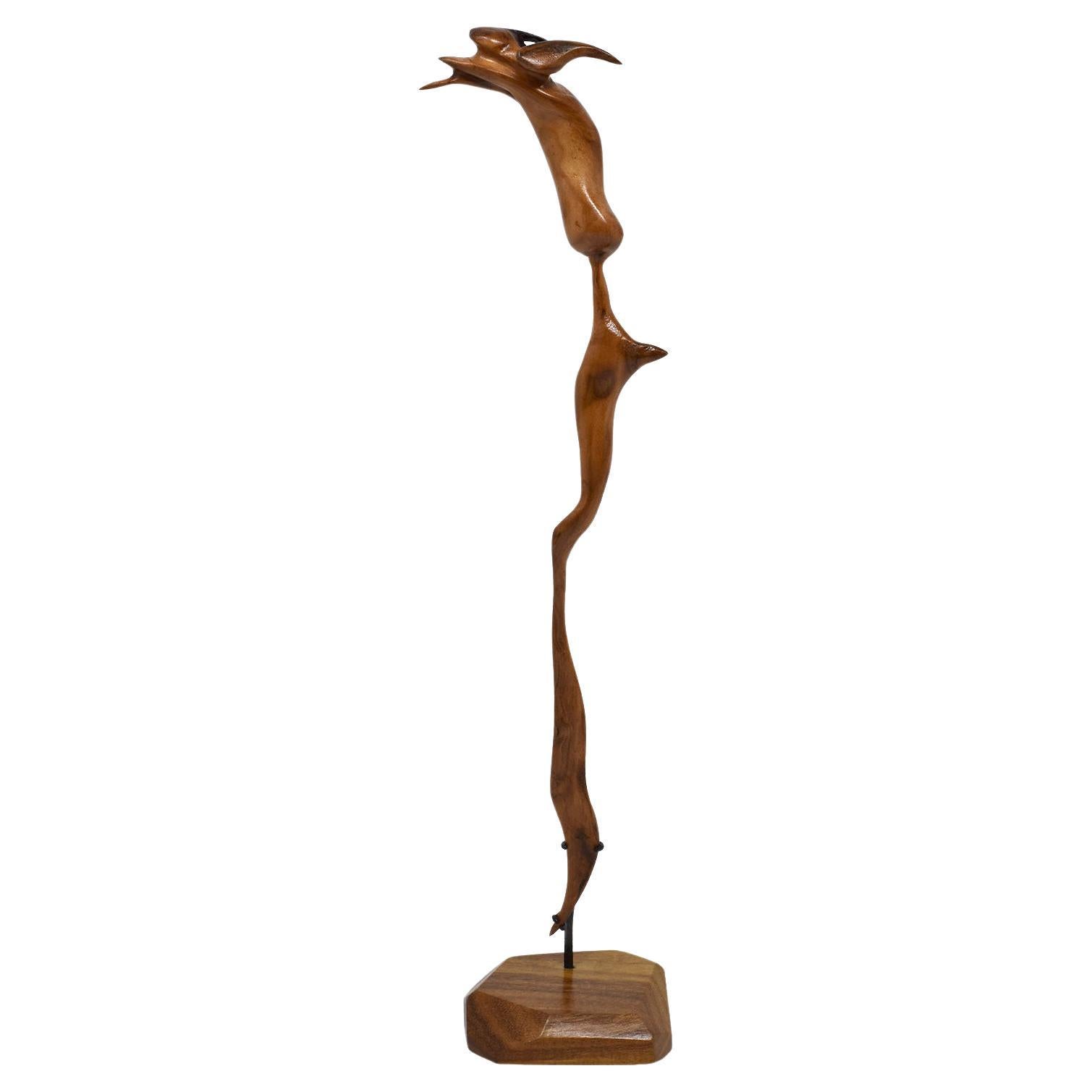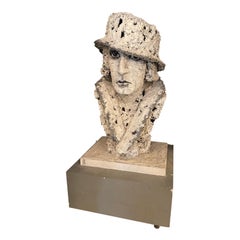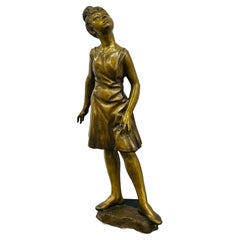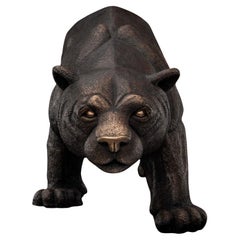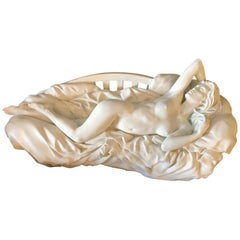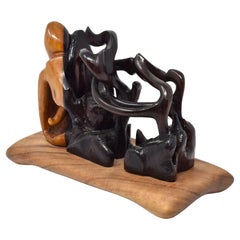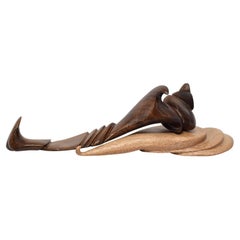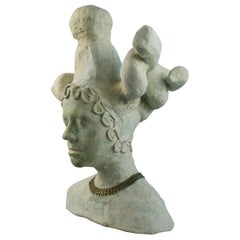Items Similar to Black Geometric Sculpture by Ursula Meyers Conceptual Artist
Want more images or videos?
Request additional images or videos from the seller
1 of 20
Black Geometric Sculpture by Ursula Meyers Conceptual Artist
About the Item
Black geometric sculpture by Ursula Meyers conceptual Artist.
Ursula Meyer (1915-2003) American sculpture signed and dated. This monumental geometric form sculpture is one the first work of art ever offered for sale, only at Greenwich Living, by renowned artist Ursula Meyer. Provenance:
From the Estate of Ann Pollon Re: The Collection of Ursula Meyer. Descendant.
Acquired from the Artist Studio.
Ursula Meyer was a German-born American sculptor, art-focused academician, and fine art
critic, who proved an influential player in the transmission of and appreciation for European born Modernism to the United States in the post-World War II era. At first a ceramicist beholden to the teachings of 1930s Germany’s Bauhaus and Italy’s Futurists, she eventually became a creator and exponent of a crisp, geometry-focused sculptural lexicon in ceramics, and later wood and metal sculpture. Her legacy includes a decades-long exploration of Minimalism, as well as experimentations in creating and deciphering Conceptual and
Expressive genres.
Born in Hanover, Germany in 1915 to Ernst Josef Meyer and Elsa Katzenstein, Ursula Meyer is
recorded as having “studied with former Bauhaus masters after the Bauhaus itself had closed
under threat of National Socialism” in 1933. Spanning the years 1934 through 1937, Ursula’s
Bauhaus tutorial is not fully documented, but it may well have included at least brief study with
the French-born Marguerite Friedlaender Wildenhain (1896-1985), the first woman to earn the
Master Potter certification in Germany, and who worked with Paul Klee, Wassily Kandinsky,
Max Kehan and Gerhard Marcks (1889-1981). Meyer is recorded as having directly worked
with Marcks, as well as with Otto Lindig (1895-1966) and the Dutch-born Jan Bonjes Van Week
(1899-1969). In 1937, she began formal study at the Reggia Scuola in Faenza, Italy. Here, she
further developed her skills as a potter, presumably bridging the organic forms and glazes
identified with the pre-Dessau Bauhaus and the more architectonic and heroically Classical
models associated with Italy’s Futurist movement that paralleled the reign of Italian dictator
Benito Mussolini. As she noted later in life, “art is an inevitable part of the larger order of
society, its language and world shared and interdependent with the…’vision’…of its specific
Time, Life, place…”
Ursula Meyer emigrated to the United States on the British passenger ship Georgic in June
1939, the manifest of which listed her as “Hebrew,” “Stateless,” and a “Potterer.” A year later,
she married Austrian-émigré musician and academician Michael Pollon (1913-1996) in New
York. In 1944, she gave birth to the couple’s only child, Ann Caroline Pollon, and in January of
the following year, she became a citizen of the United States.
With her marriage and the subsequent birth of her daughter, Ursula Meyer seemed to step
away — if only temporarily — from her established career path. But Meyer’s artistic ambitions
were not left dormant. Following her 1954 divorce from Pollon, she returned to academic
study. She exhibited a group of imposing ceramic vases at the international Expo ‘58 (1958
Brussel’s World’s Fair) — an impressive feat representing a strong commitment to studio
productivity that obviously garnered regional and national critical notice. Her work of this time
has been assessed by curators as “an interesting link to her slightly later metal and wood
sculptures. Though geometric and abstract, the ceramics appear rough and uneven, with
deliberately unfinished, expressive surfaces” no doubt beholden to her early Bauhaus
influences. Ursula completed her Bachelor of Arts degree at New York’s New School in 1960,
and received her Master of Arts degree from Columbia University two years later, at the age of
47. In the fall of 1963, Ursula Meyer’s recognized skill and talent led to her appointment as a
professor of sculpture at New York City’s Hunter College. While at Hunter, she participated in
numerous landmark exhibitions celebrating Minimalism in art and sculpture, including the serial
“Artist-Craftsmen of New York,” organized by New York’s Cooper Union Museum, in 1963,
1964, and 1965. Additional exhibition venues included: the National Design Center (1964;
1965); Artists for CORE (Gallery of American Federation of the Arts — New York; 1967); Artists
for SEDF (1967); “Cool Art” (Aldrich Contemporary Art Museum — Ridgefield, Connecticut;
1967); “Schemata 7” (Finch College Museum of Art — New York; 1967). Of these exhibitions,
Meyer included works representing a refinement of her evolving design lexicon. At this point,
she resisted the application or integration of texture to her favored geometric forms —
particularly the square. And scale became less restrictive or suppressed, with her works taking
on a greater monumentality and importance. Her “Homage to Tiny Alice” — presumably a
reference to Edward Albee’s controversial 1965 three act play, “Tiny Alice,” which addressed
financial corruption in religion — (1967) was among her most celebrated works, and it was
included in the Newark Museum’s 1968 exhibition “Cool Art: Abstraction Today,” where it was
showcased beside the works of Sol LeWitt and Robert Smithson.
From 1968 through the 1980 academic year, Meyer served as Associate Professor of Art at
Herbert Lehman College, City University of New York. Here, she had her greatest influence as
an artist and academician. She perfected her Minimalist, Euclidean-based vocabulary,
concentrating on unadorned, precise manipulations of squares, triangles, and other geometric
forms. Whether as initial sketches, maquettes, or full-scale sculptures, her works at this time
conveyed an even greater monumentality that appealed to Modern Art museum curators and
then contemporary architects designing new, multi-purpose public gathering spaces, alike.
Meyer exhibited in a number of group shows, and her work was also honored with a series of
solo exhibitions at the Hunter College Art Gallery (1968), the Herbert H. Lehman College Art
Gallery (1971), and the City University of New York’s Graduate Center (1974). Long-term
installations of her sculpture on the campuses of CUNY paralleled these exhibitions, while her
work entered into the permanent collections of the Finch College Museum (no longer extant),
The Brooklyn Museum, The Newark Museum, and the Aldrich Contemporary Art Museum.
As an art critic in a volatile era of war protests and cultural revolution, Meyer became
increasingly political, participating in such important demonstrations and reform efforts as the
short-lived but influential Art Workers’ Coalition, which was formed in 1969 in protest of the
restrictive policies of institutions like New York’s Museum of Modern Art. The AWC
successfully secured the establishment of free admission days at MoMA and other New York
museums, as well as the public identification of shortcomings regarding the celebration of work
by women and other minorities.
As a writer on art, Ursula Meyer is probably best known for her 1972 book, “Conceptual Art” —
an exploration of the then burgeoning genre whereby the idea presented by the artist is viewed
as more important than a finished product, if there is, indeed, one. Through a thoughtful and
dense text, Meyer explored the works of such artists as Vito Acconci, Terry Atkinson, David
Bainbridge, as well as others. This is perhaps her best remembered contribution to the art
world, and it still remains a pertinent introduction to the genre that she, herself would explore
following her 1980 retirement from the City University of New York.
Following her retirement, Ursula Meyer continued to create in her studio and at her desk —
expressing her artistic vision, while also serving as a critic, consultant, and lecturer. Meyer died
in 2003, leaving a remarkable body of work, spanning nearly six decades. She is counted as
an influential voice of the American Minimalist movement of the 1960s — a promoter of the
“interplay of transiency and stability” in art.
James Archer Abbott
Art Historian, Curator, and Museum Director
Author Jansen Furniture. Maison Jansen
Designing Camelot.
- Creator:Ursula Meyer (Sculptor)
- Dimensions:Height: 73 in (185.42 cm)Width: 23.5 in (59.69 cm)Depth: 30 in (76.2 cm)
- Style:Modern (In the Style Of)
- Materials and Techniques:
- Place of Origin:
- Period:
- Date of Manufacture:1970s
- Condition:Wear consistent with age and use. Minor fading.
- Seller Location:Manhasset, NY
- Reference Number:Seller: 101-Meyers11stDibs: LU863227566282
About the Seller
4.9
Platinum Seller
Premium sellers with a 4.7+ rating and 24-hour response times
Established in 1975
1stDibs seller since 2009
1,743 sales on 1stDibs
Typical response time: <1 hour
- ShippingRetrieving quote...Shipping from: Manhasset, NY
- Return Policy
Authenticity Guarantee
In the unlikely event there’s an issue with an item’s authenticity, contact us within 1 year for a full refund. DetailsMoney-Back Guarantee
If your item is not as described, is damaged in transit, or does not arrive, contact us within 7 days for a full refund. Details24-Hour Cancellation
You have a 24-hour grace period in which to reconsider your purchase, with no questions asked.Vetted Professional Sellers
Our world-class sellers must adhere to strict standards for service and quality, maintaining the integrity of our listings.Price-Match Guarantee
If you find that a seller listed the same item for a lower price elsewhere, we’ll match it.Trusted Global Delivery
Our best-in-class carrier network provides specialized shipping options worldwide, including custom delivery.More From This Seller
View AllPalatial Sculpture of Henri Robert-Marcel Duchamp by Ursula Meyer
By Ursula Meyer
Located in Manhasset, NY
Palatial bust of Henri Robert-Marcel Duchamp by Ursula Meyer. The sculpture itself measures 47" in height, 27.5" in width, and 21.5" depth acquired from the home of the most prolific American conceptual artist. Signed and dated.
Provenance:
From the Estate of Ann Pollon Re: The Collection of Ursula Meyer. Descendant.
Acquired from the artist.
Henri-Robert-Marcel Duchamp French: (28 July 1887-2 October 1968) was a French-American painter, sculptor, chess player, and writer whose work is associated with Cubism, Dada, and conceptual art He was careful about his use of the term Dada and was not directly associated with Dada groups. Duchamp is commonly regarded, along with Pablo Picasso and Henri Matisse, as one of the three artists who helped to define the revolutionary developments in the plastic arts in the opening decades of the 20th century, responsible for significant developments in painting and sculpture. Duchamp has had an immense impact on twentieth-century and twenty first-century art, and he had a seminal influence on the development of conceptual art. By the time of World War I he had rejected the work of many of his fellow artists (such as Henri Matisse) as "retinal" art, intended only to please the eye. Instead, Duchamp wanted to use art to serve the mind.
Ursula Meyer was a German-born American sculptor, art-focused academician, and fine art
critic, who proved an influential player in the transmission of and appreciation for European born Modernism to the United States in the post-World War II era. At first a ceramicist beholden to the teachings of 1930s Germany’s Bauhaus and Italy’s Futurists, she eventually became a creator and exponent of a crisp, geometry-focused sculptural lexicon in ceramics, and later wood and metal sculpture. Her legacy includes a decades-long exploration of Minimalism, as well as experimentations in creating and deciphering Conceptual and
Expressive genres.
Born in Hanover, Germany in 1915 to Ernst Josef Meyer and Elsa Katzenstein, Ursula Meyer is
recorded as having “studied with former Bauhaus masters after the Bauhaus itself had closed
under threat of National Socialism” in 1933. Spanning the years 1934 through 1937, Ursula’s
Bauhaus tutorial is not fully documented, but it may well have included at least brief study with
the French-born Marguerite Friedlaender Wildenhain (1896-1985), the first woman to earn the
Master Potter certification in Germany, and who worked with Paul Klee, Wassily Kandinsky,
Max Kehan and Gerhard Marcks (1889-1981). Meyer is recorded as having directly worked
with Marcks, as well as with Otto Lindig...
Category
Vintage 1970s American Mid-Century Modern Figurative Sculptures
Materials
Wood
Signed Bronze Ballerina by Italian Sculptor Sergio Benvenuto, Italy, 1950s
Located in Manhasset, NY
A large bronze Ballerina signed Sergio Benvenuto. A finely sculpted bronze as only Benvenuto can. Here he shines his favorite subject matter, The Ballerina. She stands poised and con...
Category
Mid-20th Century Sculptures and Carvings
Materials
Bronze
Modern Black Panther Sculpture, Hot Cast Bronze, American, 21st C.
Located in Manhasset, NY
Modern Black Panther Sculpture, Hot Cast Bronze, American, 21st C.
A signed, dated, and numbered limited edition tabletop sculpture titled Black Panther by award-winning sculptor Je...
Category
21st Century and Contemporary American Modern Animal Sculptures
Materials
Bronze
Bill Mack Tranquility Sculpture Bronze with White Patina
By Bill Mack 1
Located in Manhasset, NY
Bill Mack (Minnesota b. 1949) tranquility sculpture bronze with white patina, on base signed and numbered. It is an early work from 1994 and without a doubt, is one of his finest pieces ever. Mack's signature in the bronze, is guaranteed authentic, and, comes with a Gallery Letter of Authenticity.
From our Fine Arts and Americana collection, a stunning and massive alto-relief sculpture in bonded sand by American contemporary art legend Bill Mack.
For those who have followed the American Contemporary Art Movement over the last 20 years or so, Bill Mack needs no introduction. For those unfamiliar with his work, Bill Mack sculpts in what is referred to as “alto-relief,” which is a variation of bas-relief but incorporates even much greater depth and three dimensionality with portions of sculptures rendered in the “full round,” similar to Classic Greek and Roman sculpture and statuary.
Mack is known world-wide, with pieces held in the collections of former heads of state like ex-Presidents Ford, Reagan, and Clinton, famous actors and actresses like Sylvester Stallone and Elizabeth Taylor, as well as many corporate titans and heads of industry. Mack has exhibited internationally of course, with shows in Tokyo, Frankfurt, England, and France among many others. And certain pieces of his have been enshrined permanently in American landmarks such as his sculpture entitled “Lady,” which is now part of the permanent collection of the Statute of Liberty...
Category
1990s Modern Figurative Sculptures
Materials
Bronze
Mid-Century Modern, Abstract Marble Sculpture, Statue, Signed, Dated 1983
Located in Manhasset, NY
Mid-Century Modern Abstract Marble Sculpture / Statue, Signed and Dated, 1983
A Large and Impressive Unique abstract marble sculpture indistinctively signed and dated 1983. Broken a...
Category
Vintage 1980s Modern Abstract Sculptures
Materials
Marble
Modern African Elephant Sculpture, Hot Cast Bronze, American, 21st C.
Located in Manhasset, NY
Modern African Elephant Sculpture, Hot Cast Bronze, American, 21st C.
A signed, dated, and numbered limited edition tabletop sculpture titl...
Category
21st Century and Contemporary American Modern Animal Sculptures
Materials
Bronze
You May Also Like
"Solace" Original Sculpture by Bay Area Artist Sheridan Oakes
Located in Point Richmond, CA
Walnut on an African mahogany base
2021
Measures: 17.5 x 15.75 x 7 in. / 44 x 40 x 18.
Category
21st Century and Contemporary American Other Sculptures and Carvings
Materials
Mahogany, Walnut
"Us, " Original Sculpture by Bay Area Artist Sheridan Oakes
Located in Point Richmond, CA
Original wood sculpture
1986
Purpleheart on koa wood
Measures: 8.75 l x 4 d x 6 h in. / 22 x 10 x 15 cm.
Category
20th Century American Other Sculptures and Carvings
Materials
Walnut, Purpleheart
"The Beach, " Original Sculpture by Bay Area Artist Sheridan Oakes
Located in Point Richmond, CA
Original wood sculpture
2021
Walnut and African mahogany
Measures: 10.5 L x 2.75 W x 3 H in. / 27 x 7 x 8 cm.
Category
21st Century and Contemporary American Other Sculptures and Carvings
Materials
Walnut, Mahogany
Artist Made Large Plaster Medusa Sculpture
Located in Douglas Manor, NY
3-734 artist hand made one of a kind plaster Medusa.
Category
Vintage 1960s Abstract Sculptures
Materials
Plaster
Folk Art Artist Made Crain Sculpture
Located in Douglas Manor, NY
1271 Folk Art hand painted Crain sculpture.
Category
Vintage 1980s Sculptures and Carvings
Materials
Metal
$575 Sale Price
54% Off
"Untitled, " Bird Series #3, Original Sculpture by Bay Area Artist Sheridan Oakes
Located in Point Richmond, CA
Original, carved by hand, wood sculpture
2021
Unknown wood on a Walnut base
Measures: 9.5 x 2 / 24 x 5 cm.
Category
21st Century and Contemporary American Other Sculptures and Carvings
Materials
Walnut, Wood
Recently Viewed
View AllMore Ways To Browse
Wood Geometric Models
1930s Metal Sculpture
Metal Ship Sculpture
Bauhaus Book
Federation Furniture
Vintage Union National Furniture
Hanover Furniture
Italian Bauhaus Desk
German Hunter
Jansen Book
Arts And Crafts French Desk
Dior Pre Fall
Dior Metal Vase
French School Desk
Dutch Wood Desk
Book Form Desk
Triangle Vase
1933 Worlds Fair
